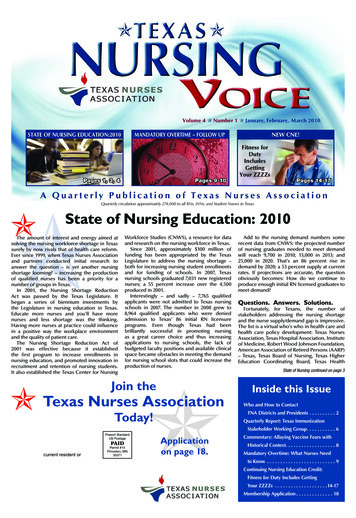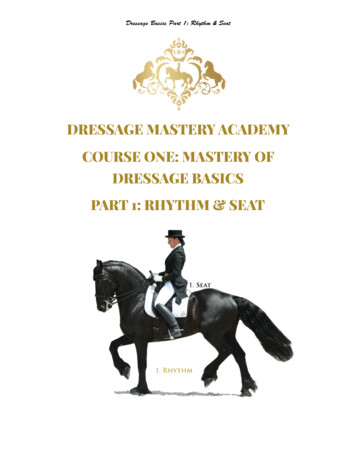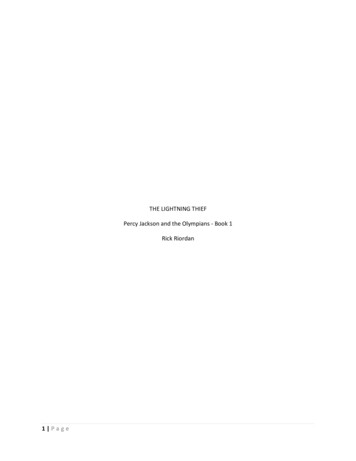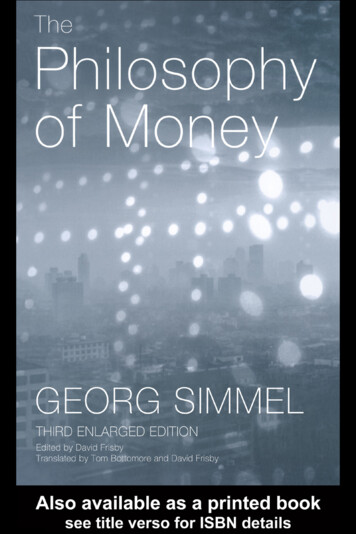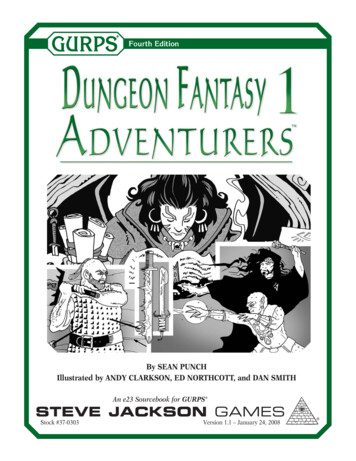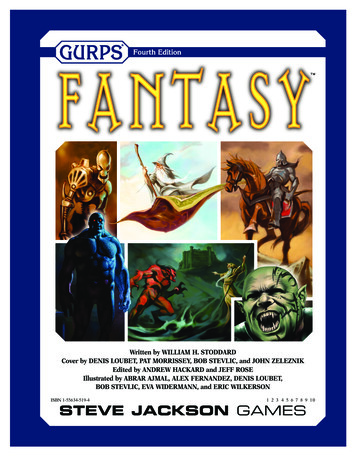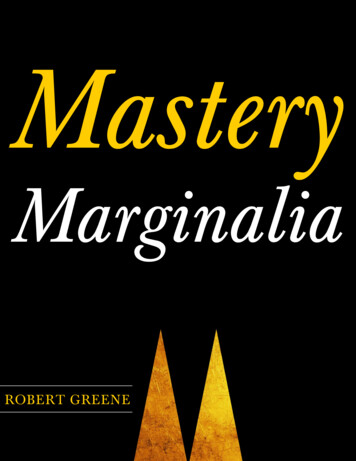
Transcription
MasteryMarginaliaROBERT GREENE1 Mastery
What follows are supplementary Mastery quotes thatcomplement and contextualize what you're reading in thebook. It is similar in nature to the side material that hasaccompanied my previous books, and is only available inthis document. As you will see, the material is best readin conjunction with the book. I hope you enjoy it and ithelps you on your own way to achieving mastery.ROBERT GREENE2 Mastery
IntroductionPp. 1 - 183 Mastery
It should also be noted that even today, humans have a potential for skills andsymbolic thought that is probably never, in any of us, fully exploited. We couldlearn languages, aspects of mathematics, crafts, or sporting skills that we do notin fact learn. We are endowed with considerably more potential than we canuse in a mere lifetime.—MICHAEL C. CORBALLIS, The Lopsided Ape: Evolution of the Generative MindStating the thing broadly, the human individual thus lives usually far within hislimits; he possesses powers of various sorts which he habitually fails to use. Heenergizes below his maximum, and he behaves below his optimum. Inelementary faculty, in co–ordination, in power of inhibition and control, inevery conceivable way, his life is contracted like the field of vision of an hystericsubject—but with less excuse, for the poor hysteric is diseased, while in the restof us it is only an inveterate habit—the habit of inferiority to our full self—that isbad.Admit so much, then, and admit also that the charge of being inferior totheir full self is far truer of some men than of others; then the practical questionensues: to what do the better men owe their escape? And, in the fluctuationswhich all men feel in their own degree of energizing, to what are theimprovements due, when they occur?In general terms the answer is plain: Either some unusual stimulus fillsthem with emotional excitement, or some unusual idea of necessity inducesthem to make an extra effort of will. Excitements, ideas, and efforts, in a word,are what carry us over the dam.—WILLIAM JAMES, “ON VITAL RESERVES”In this universe, there is a great treasure. If you possess it, then whether you area boatman or a cartman, a servant or a maid, you are a person of great fortuneand virtue and wisdom. If you don’t possess it, then even if you are an4 Mastery
emperor, a daimyo, with high rank and great wealth, you are poor andignorant, a person of low estate.—ZEN MASTER HAKUIN, Wild Ivy: The Spiritual Autobiography of Zen MasterHakuinSnell’s mention of a man who walks like a lion betraying a kinship with thebeast is not just poetical, but has a practical meaning. Trackers, in culturesdependent on hunting, learn to “get inside” the animal they are tracking, toreflect it as much as possible in their own being, what it must have been feelingand thinking as it left its track: this is how they succeed in finding it. Perhaps,when we empathise, we actually become the object of our empathy, and share itslife .We already know from the discovery of the existence of mirrorneurones that when we imitate something that we can see, it is as if we areexperiencing it. But it goes further than this. Mental representation, in theabsence of direct visual or other stimulus—in other words, imagining—bringsinto play some of the same neurones that are involved in direct perception. It isclear from this that, even when we so much as imagine doing something, nevermind actually imitate it, it is, at some level which is far from negligible, as if weare actually doing it ourselves. Imagining something, watching someone else dosomething, and doing it ourselves share important neural foundations.—IAIN MCGILCHRIST, The Master and his Emissary: The Divided Brain and theMaking of the Western WorldAt a very rudimentary level we are reminded of this reciprocity of “self” and“others” each time a newborn baby mimics an adult’s behavior. Stick yourtongue out at a newborn baby and the baby will stick its tongue out too,poignantly dissolving the boundary, the arbitrary barrier, between self and5 Mastery
others. To do this it must create an internal model of your action and then re–enact it in its own brain. An astonishing ability, given that it cannot even see itsown tongue, and so must match the visual appearance of your tongue with thefelt position of its own. We now know that this carried out by a specific groupof neurons, in the frontal lobes, called the mirror neurons. I suspect that theseneurons are at least partly involved in generating our sense of “embodied” self–awareness as well as our “empathy” for others .In addition to their obvious role in empathy, “mind reading” andevolution of language mirror neurons may have also played a vital role in theemergence of another important capacity of our minds—namely, learningthrough imitation—and therefore the transmission of culture. Polar bears had togo through millions of years of natural selection of genes to evolve a fur coat,but a human child can acquire the skill required to make a coat by simplywatching his parent slaying a bear and skinning it. Once the mirror neuronsystem became sophisticated enough, this remarkable ability—imitation andmimesis—liberated humans from the constraints of a strictly gene–basedevolution . The result was a rapid horizontal spread and vertical transmissionof cultural innovations of the kind that took place about 50,000 to 75,000 yearsago leading to the so–called great leap forward—the relatively suddendissemination of one–of–a–kind “accidental” cultural innovations like fire,sophisticated multi–component tools, personal adornments, rituals, art, shelteretc. Among the great apes, orangutans alone are reputed to display imitation ofsophisticated skills often watching the keeper and picking locks or evenpaddling across a river in a canoe. If our species becomes extinct, they may wellinherit the earth.—V.S. RAMACHANDRAN, A Brief Tour of Human ConsciousnessCarl Friedrich Gauss, the great mathematician [his] father was a bricklayer,his mother a peasant, and Gauss’s own son came nowhere close to matching his6 Mastery
father’s mathematical skills . Many of the top–notch creative geniuses appearto have no family pedigree whatsoever. Consider the cases of Newton,Shakespeare, Beethoven, and Michelangelo.—DEAN KEITH SIMONTON, Origins of Genius: Darwinian Perspectives on Creativity“Never tell anyone he has no talent. That you may not say. That you do notknow. That is the one absolute prohibition laid down.”—MARTHA GRAHAM, QUOTED IN Martha: The Life and Work of Martha Graham,Agnes de MilleWhat makes the difference between an outstandingly creative person and a lesscreative one is not any special power, but greater knowledge (in the form ofpracticed expertise) and the motivation to acquire and use it. This motivationendures for long periods, perhaps shaping and inspiring a whole lifetime.—MARGARET A. BODEN, The Creative Mind: Myths and MechanismsIf children grew up according to early inclinations, we should have nothing butgeniuses.—JOHANN WOLFGANG VON GOETHE, The Autobiography of Goethe, vol. 1But starting in the 1990s, this static view of the brain was steadily supplanted bya much more dynamic picture. The brain’s so–called modules don’t do theirjobs in isolation; there is a great deal of back–and–forth interaction betweenthem, far more than previously suspected. Changes in the operation of onemodule—say, from damage, or from maturation, or from learning and lifeexperience—can lead to significant changes in the operations of many othermodules to which it is connected. To a surprising extent, one module can eventake over the functions of another. Far from being wired up according to rigid,prenatal genetic blueprints, the brain’s wiring is highly malleable—and not just7 Mastery
in infants and young children, but throughout every adult lifetime . We cannow say with confidence that the brain is an extraordinarily plastic biologicalsystem that is in a state of dynamic equilibrium with the external world. Evenits basic connections are being constantly updated in response to changingsensory demands. And if you take mirror neurons into account, then we caninfer that your brain is also in synch with other brains—analogous to a globalInternet of Facebook pals constantly modifying and enriching each other.—V.S. RAMACHANDRAN, The Tell–Tale Brain: A Neuroscientist’s Quest for WhatMakes Us Human8 Mastery
ChapterIPp. 19 -46DISCOVER YOURCALLING:THE LIFE’S TASK9 Mastery
Although each organism is genetically constrained to develop certain featurescharacteristic of the species, these genetic codes cannot dictate the exactdestination of each developing neuron . Millions of neurons grow and dieduring this time, travel great distances, and forge connections quiteunpredictably. So even though the overall pattern of brain regions is similarfrom person to person, each individual is born with a structurally unique brain.This prenatal level of selection organizes the brain into “primary repertoires”—singular groups of neuronal connections that create the first marks ofindividuality at birth.—JOHN J. RATEY, M.D., A User’s Guide to the Brain: Perception, Attention, and theFour Theaters of the BrainAn unfulfilled vocation drains the colour from a man’s entire existence.—HONORÉ DE BALZAC, La Maison NucingenI respect a person who knows quite clearly what he wants and steadfastlyproceeds in that direction, with a true sense of direction and purpose . Believeme the greatest part of misfortune, and what is considered evil in the world,comes about because people fail to recognize their true goals, or, if they do, towork steadily toward them. They are like those who have the sense that atower should be built, but whose materials and efforts only suffice for a cottage.If you, my friend, whose highest aspiration was to come to terms withyour nature, had adapted yourself to your family, a fiancé instead of makingthe great and bold sacrifices that you have, you would have been in continualconflict with yourself and never known a single moment of peace. Whether it be reason or feeling that makes us abandon one thing foranother, or choose this over that, it is my belief that steadfastness andpersistence are the qualities most to be respected in any human being.—JOHANN WOLFGANG VON GOETHE, Wilhelm Meister’s Apprenticeship10 Mastery
What are geniuses like? What kinds of people are they? They are hugelydiverse, but a few characteristics are shared by virtually all of them. The first isan intense curiosity and dedication to one’s work .Geniuses are usually sure about what they want to do, single minded,committed, and they have a firm sense of direction. They often work with aferocity and intensity, even when impeded by doubts and frustrations. Theyalso share a capacity for sustained diligence. Isaac Newton said that hediscovered the law of universal gravitation by thinking about it continuously;Charles Darwin attributed much of his success to a capacity to reflect for yearson an unexplained problem; Einstein asserted that curiosity, determination, andhard work were vital ingredients of his effectiveness, and the great Englishpainter J.M. Turner, asked to reveal the secret of his success, gave the straightreply “the only secret I have got is damned hard work” .Perseverance is atleast as crucial as intelligence. An interesting and perhaps surprising researchfinding is that, compared with assessments of young children’s intelligence,indications of their capacity to delay gratification and avoid acting tooimpulsively are better predictors of future competence .It is especially advantageous to be able to keep trying.—MICHAEL J.A. HOWE, Genius ExplainedGeniuses are the luckiest of mortals because what they must do is the same aswhat they most want to do.—W.H. AUDENOften have I heard you say, as if speaking in sleep,"He who works in marble, and finds the shape of his own soul in the stone,is nobler than he who ploughs the soil.And he who seizes the rainbow to lay it on a cloth in the likeness11 Mastery
of man, is more than he who makes the sandals for our feet."But I say, not in sleep but in the overwakefulness of noontide,that the wind speaks not more sweetly to the giant oaks than tothe least of all the blades of grass;And he alone is great who turns the voice of the wind into a songmade sweeter by his own loving.Work is love made visible.And if you cannot work with love but only with distaste, it isbetter that you should leave your work and sit at the gate of thetemple and take alms of those who work with joy.For if you bake bread with indifference, you bake a bitter breadthat feeds but half man's hunger.And if you grudge the crushing of the grapes, your grudge distils apoison in the wine.And if you sing though as angels, and love not the singing, youmuffle man's ears to the voices of the day and the voices of thenight.—KAHLIL GIBRAN, "ON WORK"As a young woman, Florence told friends that she would one day marry andhave a son named Glenn who would be musical. She played music to him whenhe was in the womb, and she surrounded him with music from the day he wasborn: she sang and played for him, played the radio and recordings, andgenerously exposed him to what music Toronto had to offer .Glenn’s gifts quickly became apparent. “As a baby a few days old,” saidBert [his father], he would reach his arms up and “flex his fingers almost as ifplaying a scale.” When he was three years old, Glenn’s parents determined12 Mastery
that he had perfect pitch when he correctly named a note being sung on arecord . When he was four, Florence began to give him piano lessons, and hetook to the instrument instinctively. By the time he was five, he was picking outtunes and making up his own. He loved playing, and never needed to be encouraged to do so. Hewould practice for hours, and his parents eventually had to enforce daily timelimits (Fulford remembered a four–hour limit
ROBERT GREENE . 3 Mastery . Introduction Pp. 1 - 18 . 4 Mastery It should also be noted that even today, humans have a for skills and potential symbolic thought that is probably never, in any of us, fully exploited. We could learn languages, aspects of mathematics, crafts, or sporting skills that we do not in fact learn. We are endowed with considerably more potential than we can use in a .File Size: 372KBPage Count: 50People also search forBy Robert Greene mastery pdfdeathly hallowsinterview with the devil pdfleather zip-up bindermaster the daymastery robert greene pdf download
